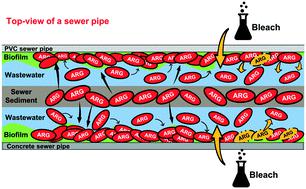当前位置:
X-MOL 学术
›
Environ. Sci.: Water Res. Technol.
›
论文详情
Our official English website, www.x-mol.net, welcomes your feedback! (Note: you will need to create a separate account there.)
Sewer biofilm microbiome and antibiotic resistance genes as function of pipe material, source of microbes, and disinfection: field and laboratory studies
Environmental Science: Water Research & Technology ( IF 5 ) Pub Date : 2020-06-24 , DOI: 10.1039/d0ew00265h William R Morales Medina 1 , Alessia Eramo 2 , Melissa Tu 2 , N L Fahrenfeld 2
Environmental Science: Water Research & Technology ( IF 5 ) Pub Date : 2020-06-24 , DOI: 10.1039/d0ew00265h William R Morales Medina 1 , Alessia Eramo 2 , Melissa Tu 2 , N L Fahrenfeld 2
Affiliation

|
Wastewater systems are recognized pathways for the spread of antibiotic resistant bacteria, but relatively little is known about the microbial ecology of the sewer environment. Sewer biofilm colonization by antibiotic resistance gene (ARG) carrying bacteria may impact interpretations of sewage epidemiology data, degrade water quality during sewer overflows, and present a hazard to utility workers. The objectives of this research were to evaluate the (1) microbiome of real and simulated sewer biofilms and their potential to accumulate ARGs and (2) susceptibility of simulated sewer biofilms to bleach disinfection. First, biofilm samples were collected from municipal sewer systems. Next, an annular biofilm reactor was used to simulate the sewer environment while controlling the pipe material (concrete vs. PVC). The reactor was operated either fed semi-batch with sewer sediment and synthetic wastewater (Sed-SB) or fed with a continuous flow of raw sewage (WW-CF). The abundance of ARGs, human fecal marker HF183, and 16S rRNA gene copies in these biofilm samples was measured with qPCR. Amplicon sequencing was performed to compare the prokaryotic diversity between samples. Finally, the susceptibility of reactor biofilm to a 4.6% bleach disinfection protocol was evaluated using viability qPCR and amplicon sequencing. Field and WW-CF biofilms contained the most ARG copies and the microbial community compositions varied between the different biofilm samples (field, Sed-SB, and WW-CF). Pipe material did not affect the abundance of ARGs in the reactor samples. However, log removal following bleach treatment suggested that the biofilm grown on PVC surface was primarily dislodged from the surface by the bleach treatment whereas more bacteria were lysed within the biofilm that remained on the concrete surface. Viable bacteria carrying ARGs were observed following 10 minutes of treatment. This study showed that sewer biofilms can accumulate bacteria carrying ARGs and that while bleach can reduce sewer biofilm density, the protocol tested here will not completely remove the biofilms.
中文翻译:

下水道生物膜微生物组和抗生素抗性基因作为管道材料、微生物来源和消毒的功能:现场和实验室研究
废水系统是公认的抗生素抗性细菌传播的途径,但对下水道环境的微生物生态学知之甚少。携带抗生素抗性基因 (ARG) 的下水道生物膜定植可能会影响对污水流行病学数据的解释,在下水道溢流期间降低水质,并对公用事业工人构成危害。本研究的目的是评估 (1) 真实和模拟下水道生物膜的微生物组及其积累 ARG 的潜力和 (2) 模拟下水道生物膜对漂白剂消毒的敏感性。首先,从市政下水道系统收集生物膜样本。接下来,使用环形生物膜反应器模拟下水道环境,同时控制管道材料(混凝土与混凝土)。PVC)。反应器以半间歇式加入下水道沉积物和合成废水 (Sed-SB) 或以连续流的原污水 (WW-CF) 加入运行。使用 qPCR 测量了这些生物膜样本中 ARG、人类粪便标记 HF183 和 16S rRNA 基因拷贝的丰度。进行扩增子测序以比较样品之间的原核多样性。最后,使用活力 qPCR 和扩增子测序评估了反应器生物膜对 4.6% 漂白剂消毒方案的敏感性。田间和 WW-CF 生物膜含有最多的 ARG 拷贝,不同生物膜样品(田间、Sed-SB 和 WW-CF)之间的微生物群落组成不同。管道材料不影响反应器样品中 ARG 的丰度。然而,漂白处理后的原木去除表明,PVC 表面上生长的生物膜主要是通过漂白处理从表面上去除的,而更多的细菌溶解在保留在混凝土表面的生物膜内。处理 10 分钟后观察到携带 ARG 的活细菌。这项研究表明,下水道生物膜可以积累携带 ARG 的细菌,虽然漂白剂可以降低下水道生物膜密度,但此处测试的协议不会完全去除生物膜。
更新日期:2020-07-31
中文翻译:

下水道生物膜微生物组和抗生素抗性基因作为管道材料、微生物来源和消毒的功能:现场和实验室研究
废水系统是公认的抗生素抗性细菌传播的途径,但对下水道环境的微生物生态学知之甚少。携带抗生素抗性基因 (ARG) 的下水道生物膜定植可能会影响对污水流行病学数据的解释,在下水道溢流期间降低水质,并对公用事业工人构成危害。本研究的目的是评估 (1) 真实和模拟下水道生物膜的微生物组及其积累 ARG 的潜力和 (2) 模拟下水道生物膜对漂白剂消毒的敏感性。首先,从市政下水道系统收集生物膜样本。接下来,使用环形生物膜反应器模拟下水道环境,同时控制管道材料(混凝土与混凝土)。PVC)。反应器以半间歇式加入下水道沉积物和合成废水 (Sed-SB) 或以连续流的原污水 (WW-CF) 加入运行。使用 qPCR 测量了这些生物膜样本中 ARG、人类粪便标记 HF183 和 16S rRNA 基因拷贝的丰度。进行扩增子测序以比较样品之间的原核多样性。最后,使用活力 qPCR 和扩增子测序评估了反应器生物膜对 4.6% 漂白剂消毒方案的敏感性。田间和 WW-CF 生物膜含有最多的 ARG 拷贝,不同生物膜样品(田间、Sed-SB 和 WW-CF)之间的微生物群落组成不同。管道材料不影响反应器样品中 ARG 的丰度。然而,漂白处理后的原木去除表明,PVC 表面上生长的生物膜主要是通过漂白处理从表面上去除的,而更多的细菌溶解在保留在混凝土表面的生物膜内。处理 10 分钟后观察到携带 ARG 的活细菌。这项研究表明,下水道生物膜可以积累携带 ARG 的细菌,虽然漂白剂可以降低下水道生物膜密度,但此处测试的协议不会完全去除生物膜。


























 京公网安备 11010802027423号
京公网安备 11010802027423号